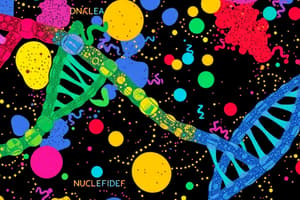Podcast
Questions and Answers
What are the monomer components of nucleotides?
What are the monomer components of nucleotides?
- 5-carbon sugar, phosphate group, nitrogenous base (correct)
- 4-carbon sugar, phosphate group, nitrogenous base
- 5-carbon sugar, phosphate group, amino acid
- 6-carbon sugar, phosphate group, nitrogenous base
Which type of nucleic acid has ribose as its sugar component?
Which type of nucleic acid has ribose as its sugar component?
- RNA (correct)
- mRNA
- tRNA
- DNA
What role do nucleic acids play in cells?
What role do nucleic acids play in cells?
- Regulate cell division
- Stimulate protein synthesis
- Produce energy for the cell
- Carry information and make up genetic material (correct)
What is the primary composition of the backbone of nucleic acids?
What is the primary composition of the backbone of nucleic acids?
Which type of nucleic acid usually forms a chain of single bases?
Which type of nucleic acid usually forms a chain of single bases?
What gives RNA and DNA their 'ladder-step' order of nucleotides within their molecules?
What gives RNA and DNA their 'ladder-step' order of nucleotides within their molecules?
What are the bases found in RNA and DNA?
What are the bases found in RNA and DNA?
Who discovered nucleic acid in 1869 at the University of Tübingen, Germany?
Who discovered nucleic acid in 1869 at the University of Tübingen, Germany?
What is the term synonymous with polynucleotide?
What is the term synonymous with polynucleotide?
When was the double-helix structure of DNA proposed?
When was the double-helix structure of DNA proposed?
Where were nucleic acids first discovered?
Where were nucleic acids first discovered?
What are the basic components of biological nucleic acids?
What are the basic components of biological nucleic acids?
In which year did the Avery–MacLeod–McCarty experiment show that DNA is the carrier of genetic information?
In which year did the Avery–MacLeod–McCarty experiment show that DNA is the carrier of genetic information?
What is the overall name for DNA and RNA?
What is the overall name for DNA and RNA?
Study Notes
Nucleic Acid Composition
- The monomer components of nucleotides are a sugar molecule, a phosphate group, and a nitrogenous base.
- Ribose is the sugar component of RNA (ribonucleic acid).
Functions and Characteristics
- Nucleic acids play a crucial role in cells as they contain genetic information necessary for the development and function of an organism.
- The primary composition of the backbone of nucleic acids is a sugar-phosphate molecule.
RNA and DNA Structure
- RNA usually forms a chain of single bases.
- Hydrogen bonds between complementary nitrogenous bases give RNA and DNA their 'ladder-step' order of nucleotides within their molecules.
History and Discovery
- Friedrich Miescher discovered nucleic acid in 1869 at the University of Tübingen, Germany.
- The term synonymous with polynucleotide is nucleic acid.
- James Watson and Francis Crick proposed the double-helix structure of DNA in 1953.
Key Facts
- The bases found in RNA and DNA are adenine (A), guanine (G), cytosine (C), and thymine (T) in DNA, and uracil (U) in place of thymine in RNA.
- Nucleic acids were first discovered in pus cells.
- The basic components of biological nucleic acids are sugar molecules, phosphate groups, and nitrogenous bases.
- The Avery–MacLeod–McCarty experiment in 1944 showed that DNA is the carrier of genetic information.
- The overall name for DNA and RNA is nucleic acids.
Studying That Suits You
Use AI to generate personalized quizzes and flashcards to suit your learning preferences.
Description
Test your knowledge about nucleic acids, the building blocks of DNA and RNA. Learn about the composition of nucleotides and the differences between DNA and RNA at the molecular level.




